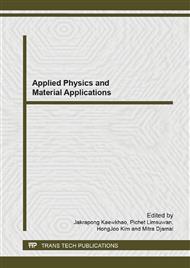p.295
p.299
p.303
p.307
p.311
p.315
p.319
p.323
p.327
The Crystalline Monitoring of Oxide Compound: The Case Study of Influence from Heat Treatment
Abstract:
In present study, the structural and thermal characterizations of the natural material were investigated, the relationship between the crystal structure and thermal treatment were studied. The relationship between temperature and features of the crystal structure were determined qualitative by three conventional analysis techniques, X-Ray Diffraction (XRD), Energy Dispersive X-Ray Fluorescence (EDXRF) and Fourier Transform Infrared Spectroscopy (FT-IR). The results show that the Babylonia areolata have a crystalline of calcium carbonate in phase aragonite, and the rice husks have amorphous structure. Another that, both sample annealed under air atmosphere, the effect of temperature induced both materials have phase transformation. Both sample transformed into oxide compound at temperature about 900C. In addition, the composition of both mineral and the level of the metals element were investigated by EDXRF. Functional group and chemical environment of silicon ions and calcium ions were identified by FT-IR, respectively.
Info:
Periodical:
Pages:
311-314
Citation:
Online since:
September 2013
Authors:
Price:
Сopyright:
© 2013 Trans Tech Publications Ltd. All Rights Reserved
Share:
Citation:


